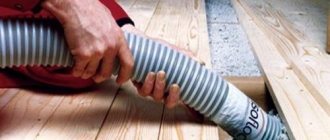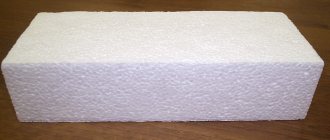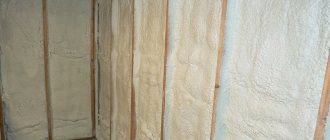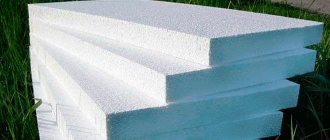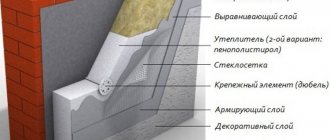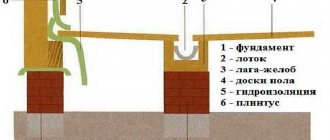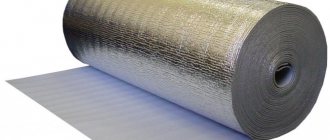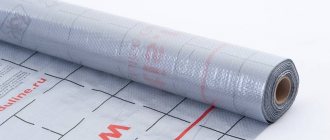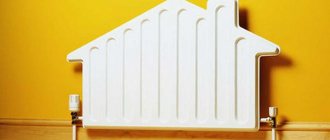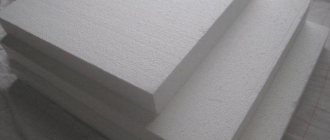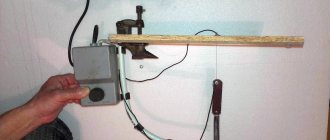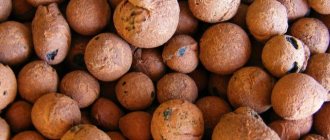Unfortunately, the characteristics of mass-produced buildings, especially old housing stock, are not characterized by increased noise insulation characteristics. A standard reinforced concrete slab as a wall of a panel house, and gypsum-based analogues in brick buildings, have a high vibration transmission coefficient, including in the frequency range perceived by human hearing.
In other words, neighbors can perfectly hear not only loud music, the TV, but also ordinary speech. The external walls are also insufficiently soundproofed. Street noise easily penetrates into homes, annoying its inhabitants.
The situation suggests two ways out of the current situation. Move to another place, or isolate yourself from extraneous sounds. The first method is undoubtedly radical and it is not always possible to take such a step. But in the second case, you can change the situation in ways that are affordable and labor intensive. A wide selection of materials with soundproofing characteristics will help with this.
Why choose polystyrene foam for soundproofing your home?
To soundproof rooms, a wide range of products with the necessary qualities are used. If certain conditions are met, identical results can be achieved in all cases.
The answer to the question why polystyrene foam is so popular among both craftsmen and users will be its following qualities:
- affordable price. In comparison with other types of soundproofing materials, polystyrene foam is not only competitive, but is among the top materials in this area;
- ease of installation. The dimensions of the sheets allow you to form the required dimensions of the parts from which the soundproofing layer is mounted. Processing foam plastic is not difficult. It cuts easily with a knife;
- ecological and sanitary-hygienic cleanliness. There has been much debate over these characteristics, but studies have shown that the volatiles emitted are not in sufficient concentration to cause harm to human health. Exceptional cases of allergic reactions are caused by individual intolerance and are extremely rare. Fears about foam soundproofing are clearly overblown;
- long service life. The material is not susceptible to infection by mold, fungi and other microorganisms;
- stability of geometric dimensions. The coefficient of dynamic change in dimensions is extremely small and does not depend on humidity and non-critical temperature fluctuations;
- good sound insulation properties. The porous structure of the foam effectively dampens vibrations. Proper installation will reduce household noise to the required level.
The functional characteristics of polystyrene foam necessary for the implementation of a housing soundproofing project can be supplemented with a number of related qualities. Light weight makes transportation easy. It can be stored for a long time in unheated and utility rooms without compromising the quality of the product.
Among the disadvantages, there is a relatively low melting point of polystyrene foam, which actually has no practical significance:
- simple foam softens at 140° C;
- epoxy at 170° C;
- polyurethane foams soften at temperatures above 230° C.
Anti-foam is added to construction foam, which blocks the combustion process. The material itself does not support fire for more than 4 seconds. After which it goes out. But in the case of an open fire nearby, the process continues.
What to choose - polystyrene foam or mineral wool?
For a specialist in the field of insulation, the question of what is better and more reliable to insulate a house - foam plastic or mineral wool - can lead to temporary confusion. After all, one material cannot be unambiguously recommended for all elements of a building with different requirements for flammability, thermal insulation, resistance to moisture, level of sound insulation, ability to deform during operation, and so on. Therefore, a real specialist, after asking leading questions, will give advice based on the requirements taken into account, which is better suited, mineral wool or polystyrene foam, for a certain part of the structure.
You can figure this out yourself by studying and comparing the properties of materials and their behavior under certain conditions. Now in more detail.
Thermal insulators of the mineral wool class include glass fiber (glass wool), fiber from blast furnace slag (slag wool), gabbro and diabase fiber with binding components (stone wool). Glass wool and slag wool are definitely not suitable for insulating any structural elements of buildings. To work with these materials, protective equipment is required. Regular stone wool is less hazardous to health. But still, for private housing construction, they choose safe basalt wool, which does not contain any binders. Therefore, it can withstand cooling down to -190°C and heating up to +870°C without compromising its thermal insulation properties. Release form: rolls, mats, sheets. We will consider basalt stone wool as an alternative to polystyrene foam, deciding the question: what is warmer than polystyrene foam or mineral wool? Let's compare the technical characteristics of the materials.
Soundproofing properties
The specific fibrous structure and weight of mineral wool help to dampen noise well and increase acoustic comfort in the room. Expanded polystyrene is very modest sound insulation. It is not worth considering it as a serious sound insulator.
Soundproofing concrete floors with mineral wool.
Vapor permeability
This property helps to avoid the accumulation of moisture, condensation and, as a result, damage to building materials from fungal attack and freezing. For mineral wool this figure is higher. This means that for walls that must “breathe” (especially wooden ones), foam insulation is not suitable. In this case, mineral wool is used with the proviso that the insulating “pie” will not allow it to accumulate moisture, which will cause the insulation properties to be lost. Polystyrene foam does not allow steam to pass through, but does not accumulate it either. Therefore, it is better suited than its competitor for planned insulation indoors. And polystyrene foam copes with its task of preventing wet vapors from reaching the walls.
In the competition - mineral wool or polystyrene foam - on the issue of vapor barrier, each material has its own pros and cons.
Fire safety
Human lives depend on combustion resistance and the amount of toxic substances released during a fire. Therefore, the importance of this indicator is obvious.
Stone wool can be considered a non-combustible material. Without melting up to +870°C, it disintegrates under the action of an open flame with a temperature of +600°C-+700°C into hot dust.
The fire resistance of polystyrene foam is its weak point. At +80°C, the foam already melts, and when burned it becomes a source of toxic smoke. That is why it is prohibited to use polystyrene foam for internal insulation of residential ceilings. Extruded material has the best performance. Pyrine retardants added to some types of foam significantly improve its fire resistance, but do not completely solve the problem.
Note! When insulating the facade from the outside, it is advisable to insulate areas adjacent to door and window openings with stone wool to increase their fire resistance. In an emergency, this will become an additional protective barrier against fire. You need to use high-density material - it is more resistant to the formation and accumulation of condensation.
Thermal conductivity
This is the main indicator for insulation. The lower it is, the better the material is as a barrier against cold. The thermal conductivity of the insulation materials under consideration is almost the same (foam plastic is slightly superior to stone wool of similar density). But the ability to gain moisture and thereby lose some of its properties limits the use of mineral wool in damp rooms, underground, for foundation insulation.
Convenience and safety of installation
Let's look at the features of each material.
Styrofoam:
- Lightweight slabs are convenient for transportation, carrying, and self-installation.
- The material is easy to cut to size.
- For installation on vertical and horizontal surfaces, a wooden frame is not required. Sheets can be glued.
- Expanded polystyrene is a fragile material with low resistance to mechanical stress; its sheets break easily.
- The slabs to be laid should be joined carefully, ensuring minimal joint gaps. They are the ones who can become bridges of cold.
Mineral wool:
- Stone wool in any design (slabs, rolls) is tightly laid without the formation of cold bridges at the joints.
- High-density material can be easily cut with a hacksaw.
- Vertical laying of the material requires the presence of a frame. This increases the cost of insulation and requires additional effort and time.
- Even work with practically safe basalt wool should be carried out in special protective equipment. Getting small particles of cotton wool on mucous membranes and eyes can seriously damage your health.
Lifetime
The service life of both materials under ideal operating conditions and proper maintenance is tens of years. But harsh operating conditions, the lack of an additional protective layer for polystyrene foam (the material is destroyed by sunlight, impacts, mechanical loads), high humidity for mineral wool (wet insulation loses its properties and becomes deformed, after drying its properties are not fully restored), can make their own adjustments. rodents building nests in the insulation and turning it into dust.
The considered characteristics of insulation materials can be summarized in a comparative table.
| Characteristics and properties | Insulation material | |
| Mineral wool | Expanded polystyrene | |
| Soundproofing | + | – |
| Thermal conductivity | + | + |
| Vapor permeability | + – | + – |
| Fire safety | + | – |
| Ease of installation | + – | + |
| Life time | + | + |
| Water absorption | – | + |
Types of foam
The construction industry offers a significant range of products in this class. Foam grades reflect its origin and characteristics. There are two types of material. Pressed and non-pressed. It is not difficult to distinguish from. The first is a single porous body, and the second is produced by sintering ready-made granules, which is clearly visible visually. For sound insulation, preference is given to non-pressed soft foam. It effectively dampens vibrations and is easy to process.
In construction, the most popular types are the following, which indicate the following foam markings:
- PSB. Pressless foam plastic of several modifications. The last digit in the abbreviation means the strength class. For example, PSB-S-50 is the most durable material in this category. Used where mechanical strength is required. PSB-S-25 is a universal material widely used in construction for many purposes. The softest product is PSB-S-15. Due to excessive fragility and fragility, it is rarely used. It can become attractive solely because of its low price. If the letter F appears in the name, this means that the product can be used in facade work.
- PPU. Foamed mass based on polyurethane. One of the modifications is foam rubber. The material is elastic and very convenient to use, but its cost is quite high. For this reason it is used in limited quantities.
- PPE. The polyethylene base provides elasticity and wear resistance. This marking can be found in hardware stores on many products, but is rarely used for sound insulation.
- PVC. Polyvinyl chloride foam. It is distinguished by the absence of substances harmful to health. The environmental friendliness of the material, which manifests itself under normal operating conditions, is attractive, but danger arises during combustion. Exceeding the critical temperature leads to the destruction of structural bonds and the release of extremely dangerous hydrogen chloride, which, in combination with the liquid, begins to release hydrochloric acid. For the respiratory tract, the smoke emitted by PVC foam is very dangerous.
The most popular and widespread type of polystyrene foam is considered to be the material labeled PSB. Excellent performance combined with an affordable price make it attractive in all respects.
Do not confuse sound-absorbing and sound-insulating materials. Their purpose is different. Sound absorption involves eliminating sound vibrations occurring indoors. This creates exceptional opportunities for organizing the necessary acoustics. It is used in the decoration of studios and other premises with a regulated sound background.
Installation features
At the installation stage, the future characteristics of the soundproofing layer are laid down. The installation method is a key factor. Sound insulation will be satisfactory if there is an understanding of the processes taking place. This will allow you to most effectively protect your home from extraneous sounds and avoid mistakes.
To do this, it is necessary to consider all installation methods with an assessment of the final result:
Might be interesting
Thermal insulation
Distinctive features and variety of ceiling tiles…
Thermal insulation
Features and use of mineral wool
Noise insulation
How to soundproof a balcony roof yourself?
Noise insulation
Soundproofing sewer pipes in an apartment
- Fixation with glue. Convenient, economical and most effective installation method. If foam plastic is glued to concrete, brick, plaster, then the most complete fit is ensured. Vibrations in this case are damped well. Do not use adhesives
- Installation of foam plastic with fasteners. The method is good for external use. Often used for insulation and soundproofing of walls.
- Inserting into the cells of the sheathing. A large number of individual elements creates risks for complete shelter. It is difficult to avoid gaps and cracks. Rigid metal profiles that transmit vibrations well also do not contribute to good sound insulation.
If you choose the method of filling the sheathing cells with foam plastic, then a wooden structure is preferable to a metal one. When the height of the ceiling allows, it is better to lower the suspended structure by the thickness of the foam, and make the soundproofing layer solid. If this installation method is not possible, the gaps between the metal profile and the foam plastic are filled with elastic material (mineral wool, foam rubber, etc.). Foam sound insulation is effective with minimal gaps, since sound vibrations are transmitted through the air. The porous structure of the base material completely eliminates the transmission of sound vibrations. By eliminating the possibility of movement of air masses, the desired noise levels are achieved.
What is desirable to insulate with foam plastic
The material is distinguished by its ability not to lose its properties in high environmental humidity.
- Polystyrene foam is very convenient for insulating retail outlets, bathhouses, gazebos and other structures that fall under the definition of “small architectural forms.”
- Expanded polystyrene boards are an ideal solution for insulating loggias and balconies.
- Insulation of utility buildings, production workshops and premises can also be done using polystyrene foam.
- Interfloor ceilings, floors, and the roof in use are insulated with high-density material. Waterproofing is placed under it and concrete is poured on top.
- The outside of the house is effectively insulated with foam plastic. It is more convenient to work with brick and block walls.
- Cold roof and forced-ventilated residential attic.
- The foundation of any house and the floor of the first level in a house without a basement.
Comprehensive sound insulation measures
The most effective way to get rid of excess noise. All possible sources of sound penetration into the home are determined, including sockets, ventilation openings, shafts, windows, and doors. Polystyrene foam will be a good helper in this matter. All large openings and communication channels can be insulated with pieces of material. Complete sealing is ensured by the combined use of polystyrene foam with other sound insulators.
Just don’t overdo it in your desire for a quiet, comfortable life. It is possible to interfere with the work of engineering communications on the condition that neighbors and the functionality of support systems will not suffer from this. For example, you cannot block the ventilation hole, but gluing sound-absorbing material to the inner walls of the technological channel, without noticeably reducing its cross-section, is allowed.
What is better for roof insulation?
Expanded polystyrene is best suited for roof insulation. The roof may leak or allow moisture to pass through, which is detrimental to mineral wool. Polystyrene foam will additionally insulate the building from the penetration of large amounts of moisture. The only disadvantage of using foam plastic on the roof is its strong heat up to +100 degrees. S. in the hot season. Polystyrene releases harmful fumes when exposed to high temperatures. When using mineral wool to insulate a roof, it is necessary to carefully isolate it from moisture.
How to avoid common mistakes and get the desired result
Polystyrene foam is an excellent material for insulating interior walls from extraneous sounds. However, you can also hear a negative opinion, to the point that no positive effect is observed or it is insignificant. Why do many craftsmen prefer to install polystyrene foam rather than mineral wool and similar materials? The answer is simple. Incorrect installation.
Indeed, basic errors when forming a soundproofing layer will not give the expected effect. When carrying out work, you must adhere to the main rule - do not leave cracks or gaps, ensuring a tight fit to the base and to individual parts of the structure.
An effective soundproofing layer will be obtained if the gaps between the parts of the foam are filled with polyurethane foam. A tight fit to the base will be ensured. The overall vibration-absorbing characteristics are improved. The method will save fasteners without compromising the strength properties of the sound insulation layer.
Very often, plaster is made over polystyrene foam. It is very convenient, practical and inexpensive. In order for the layer of building mixture to be firmly held and have the necessary strength characteristics, a reinforcing mesh is first fixed onto the prepared area. Most often this is a synthetic material, but you can also use a metal analogue made from small-section wire or a manufactured stamping method.
Features of decorative finishing for soundproofing with foam plastic
Many questions arise when finishing a soundproofed wall. For example, is it possible to glue wallpaper onto foam plastic? How to install drywall? Will the tiles stick securely if the tiles are glued to foam plastic? Any job can be done, but whether the result will satisfy you is a big question. To successfully complete finishing work, you need to understand the principle of working with foam plastic.
The material is quite soft and subject to deformation under physical influence, even minor. Having created a reinforcing layer on the surface, you can use absolutely any finishing material.
If you need to glue tiles in a room, then doing it directly onto the foam is impractical. In this case, it would be wise to first make a layer of plaster or install drywall, and then glue the tiles to your health; they will last as long as a concrete or brick wall. The same principle should be applied when wallpapering.
Moreover, the glue for this type of work is water-soluble and you will have to wait a long time for it to dry, since it cannot be absorbed into the synthetic mass. First the reinforcing, leveling compound, and then the wallpaper. If all operations are done correctly, the performance characteristics of the surface will not be affected, but the noise in the apartment will be reduced.
Reviews of sound insulation made of polystyrene foam
Buyers who have tried Penoplex in action note the light weight but large volume of the panels. The mats take up a lot of space in the room, but are easy to cut and, if desired, quickly transported to the next room. If soundproofing is installed correctly, your home can be finished in one day. The work does not require special tools or special skills; all steps can be easily completed with your own hands.
According to reviews of Penoplex sound insulation, the material does an excellent job of thermal insulation of floors. It is a good layer between other layers, together with them forming an impeccable coating that completely retains heat in the house. Carpets, runners, and other coverings are no longer needed, since the floors are warm and your feet do not freeze when in contact with them.
